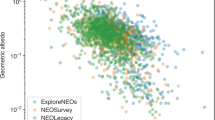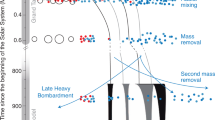Abstract
THIS communication presents evidence for the terrestrial origin of the objects which allegedly fell from the sky at Igast, Estonia, in 1855 (ref. 1).
This is a preview of subscription content, access via your institution
Access options
Subscribe to this journal
Receive 51 print issues and online access
$199.00 per year
only $3.90 per issue
Buy this article
- Purchase on Springer Link
- Instant access to full article PDF
Prices may be subject to local taxes which are calculated during checkout
Similar content being viewed by others
References
Grewingk, C., and Schmidt, C., Uber die Meteoritenfälle von Pillistfer, Buschof, und Igast, in Liv-, Ehst-und Kurland, Archiv für die Naturkunde Livlands, Ehstlands und Kurlands, 3, Series 1, 421 (1864).
O'Keefe, J. A., and Lowman, P. D., jun., New Investigations of the Alleged Meteorites from Igast, Estonia, NASA Technical Note D-490 (1961).
Lydon, P. A., Silicate Slag Trinity County, Min. Inform. Service, Calif. Div. Mines and Geol., 17, No. 6, June (1964).
Author information
Authors and Affiliations
Rights and permissions
About this article
Cite this article
LOWMAN, P., O'KEEFE, J. Terrestrial Origin of the Igast Objects. Nature 209, 67–68 (1966). https://doi.org/10.1038/209067a0
Issue Date:
DOI: https://doi.org/10.1038/209067a0
Comments
By submitting a comment you agree to abide by our Terms and Community Guidelines. If you find something abusive or that does not comply with our terms or guidelines please flag it as inappropriate.



